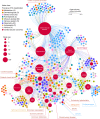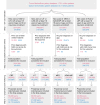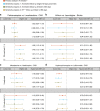Network-based approach to prediction and population-based validation of in silico drug repurposing
- PMID: 30002366
- PMCID: PMC6043492
- DOI: 10.1038/s41467-018-05116-5
Network-based approach to prediction and population-based validation of in silico drug repurposing
Abstract
Here we identify hundreds of new drug-disease associations for over 900 FDA-approved drugs by quantifying the network proximity of disease genes and drug targets in the human (protein-protein) interactome. We select four network-predicted associations to test their causal relationship using large healthcare databases with over 220 million patients and state-of-the-art pharmacoepidemiologic analyses. Using propensity score matching, two of four network-based predictions are validated in patient-level data: carbamazepine is associated with an increased risk of coronary artery disease (CAD) [hazard ratio (HR) 1.56, 95% confidence interval (CI) 1.12-2.18], and hydroxychloroquine is associated with a decreased risk of CAD (HR 0.76, 95% CI 0.59-0.97). In vitro experiments show that hydroxychloroquine attenuates pro-inflammatory cytokine-mediated activation in human aortic endothelial cells, supporting mechanistically its potential beneficial effect in CAD. In summary, we demonstrate that a unique integration of protein-protein interaction network proximity and large-scale patient-level longitudinal data complemented by mechanistic in vitro studies can facilitate drug repurposing.
Conflict of interest statement
A.-L.B. and J.L. are co-founders of Scipher, a startup that uses network concepts to explore human disease. S.S. is consultant to Aetion, Inc., a software manufacturer in which he also owns equity. The remaining authors declare no competing interests.
Figures




References
Publication types
MeSH terms
Substances
Grants and funding
- U01 HL108630/HL/NHLBI NIH HHS/United States
- U01 HG007690/HG/NHGRI NIH HHS/United States
- P01 HL083069/HL/NHLBI NIH HHS/United States
- ME-1303-5638/Patient-Centered Outcomes Research Institute (PCORI)/International
- RC2 HL101543/HL/NHLBI NIH HHS/United States
- P50 GM107618/GM/NIGMS NIH HHS/United States
- HG007690/U.S. Department of Health & Human Services | National Institutes of Health (NIH)/International
- U01 HG001715/HG/NHGRI NIH HHS/United States
- P50 HG004233/HG/NHGRI NIH HHS/United States
- R37 HL061795/HL/NHLBI NIH HHS/United States
- K99 HL138272/HL/NHLBI NIH HHS/United States
- HL108630/U.S. Department of Health & Human Services | National Institutes of Health (NIH)/International
- GM 107618/U.S. Department of Health & Human Services | National Institutes of Health (NIH)/International
- U41 HG001715/HG/NHGRI NIH HHS/United States
- HL106373/U.S. Department of Health & Human Services | National Institutes of Health (NIH)/International
- HL016795/U.S. Department of Health & Human Services | National Institutes of Health (NIH)/International
LinkOut - more resources
Full Text Sources
Other Literature Sources
Miscellaneous

